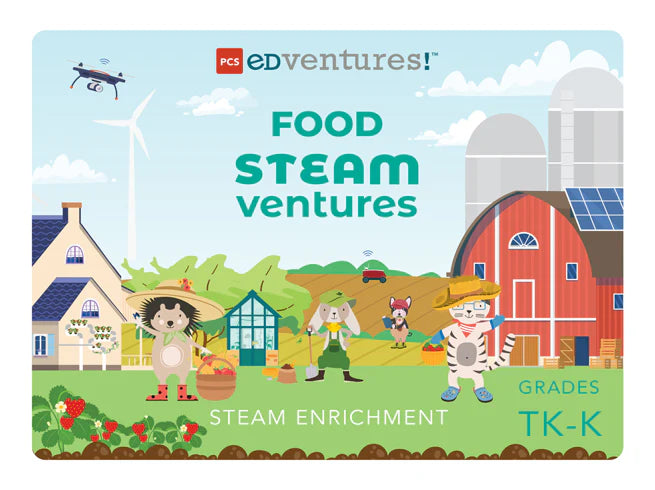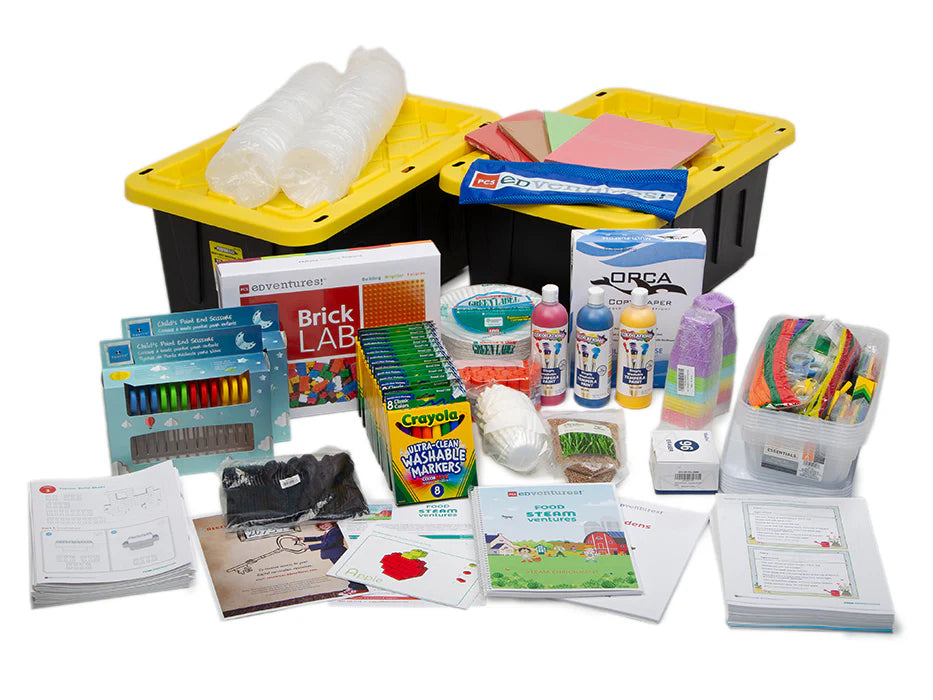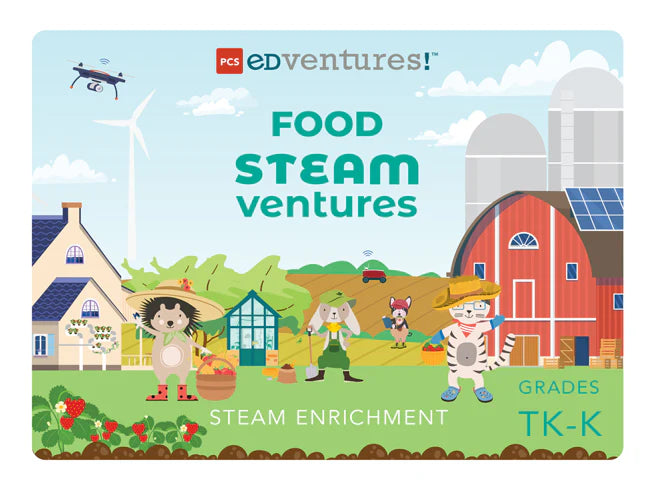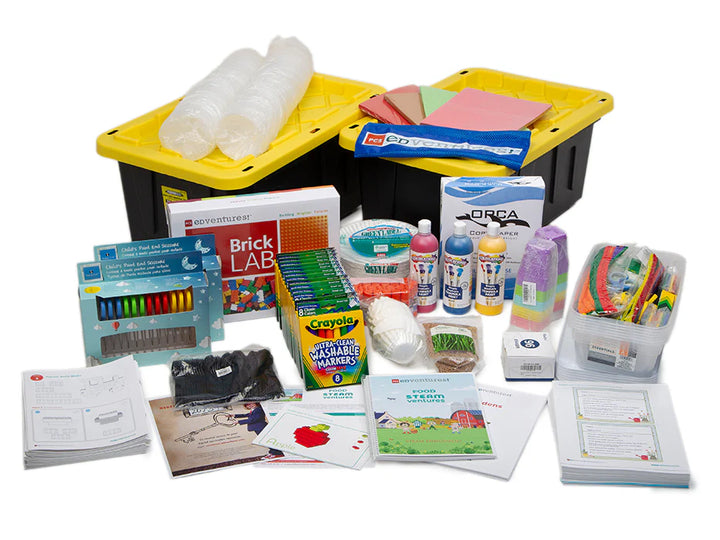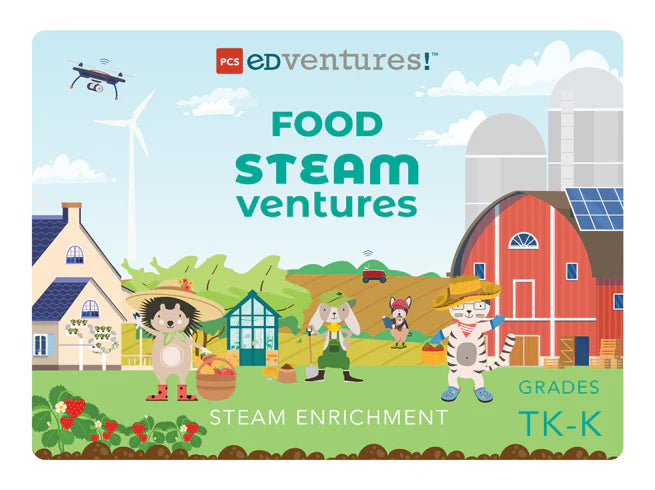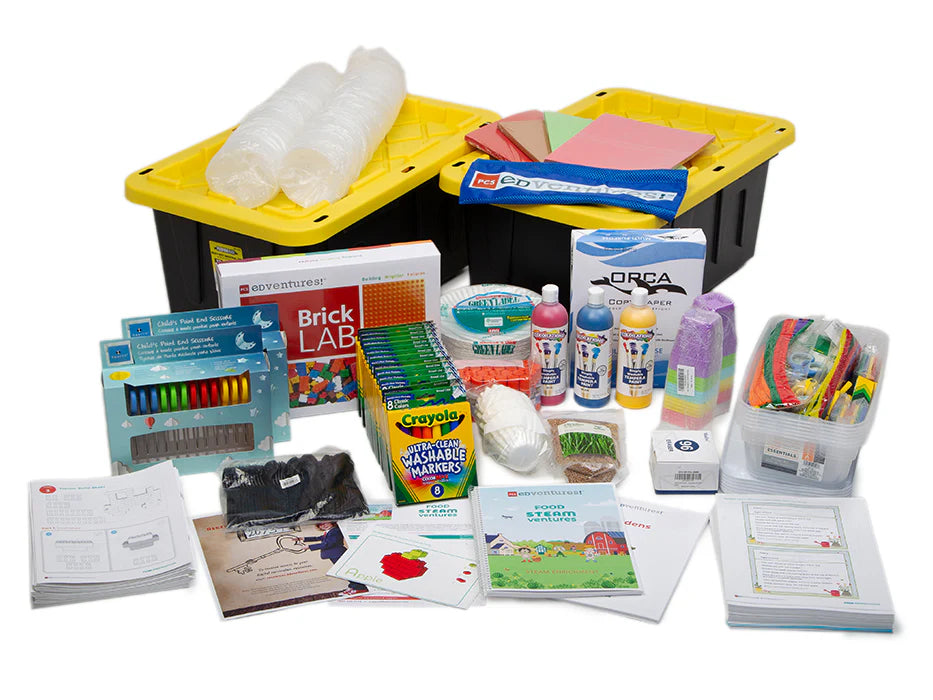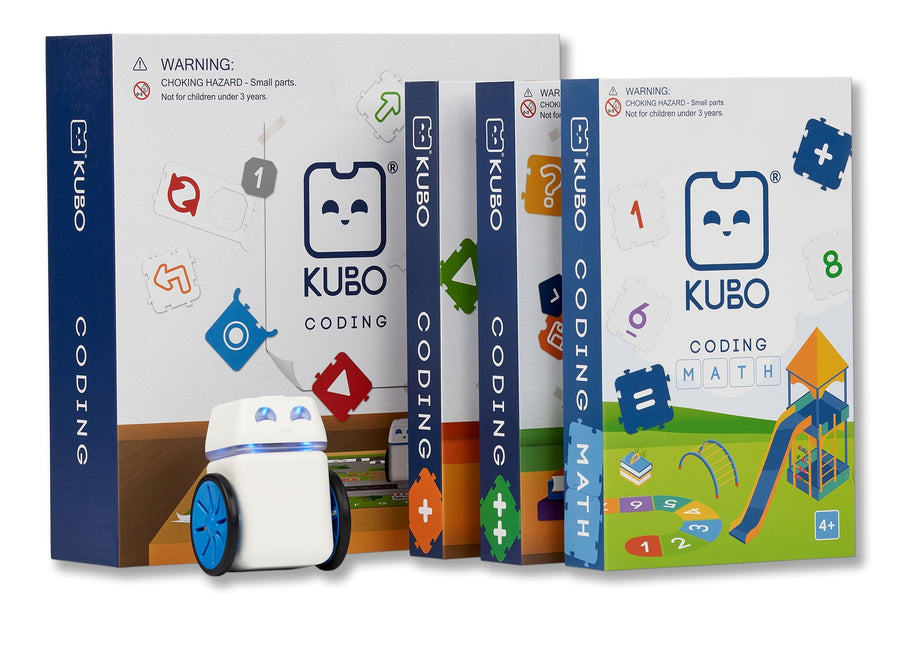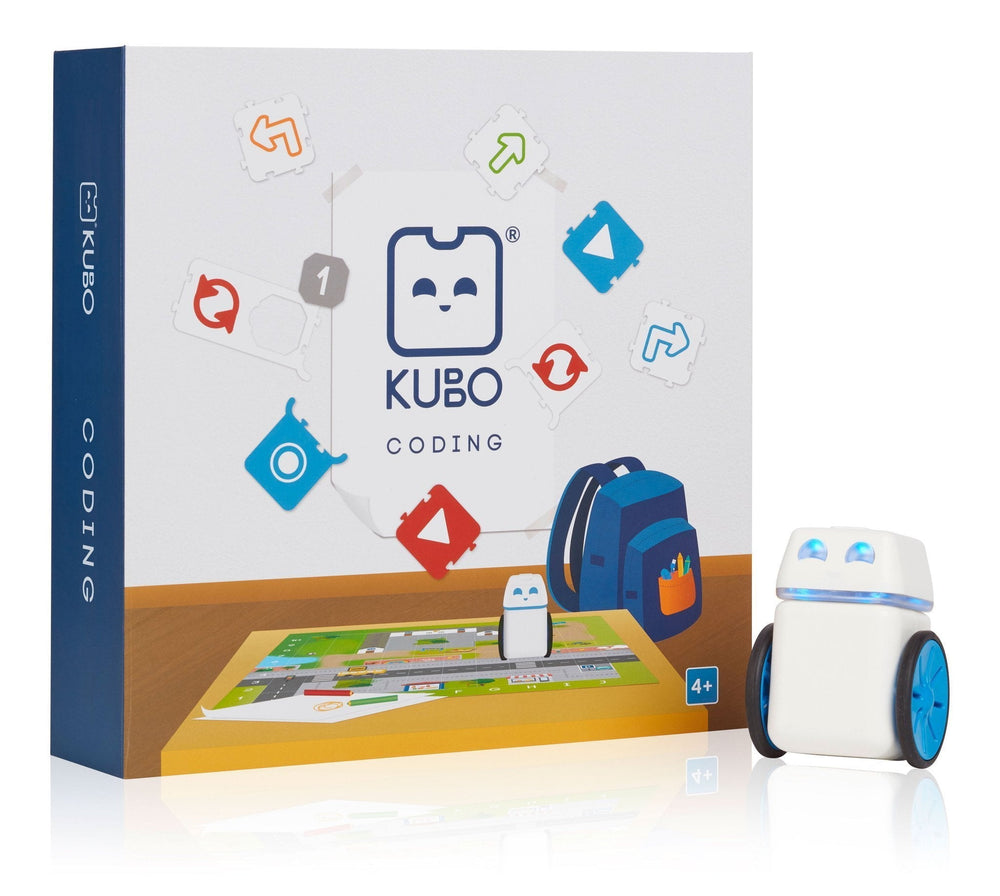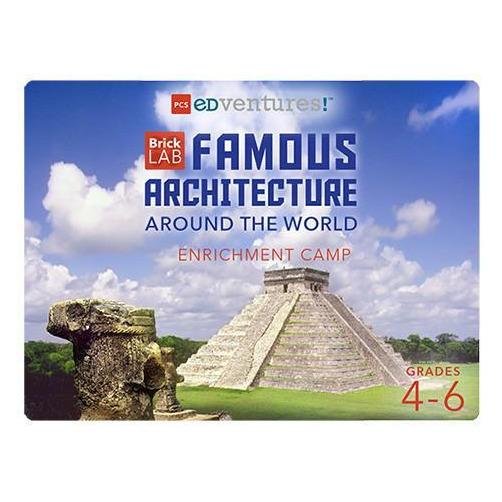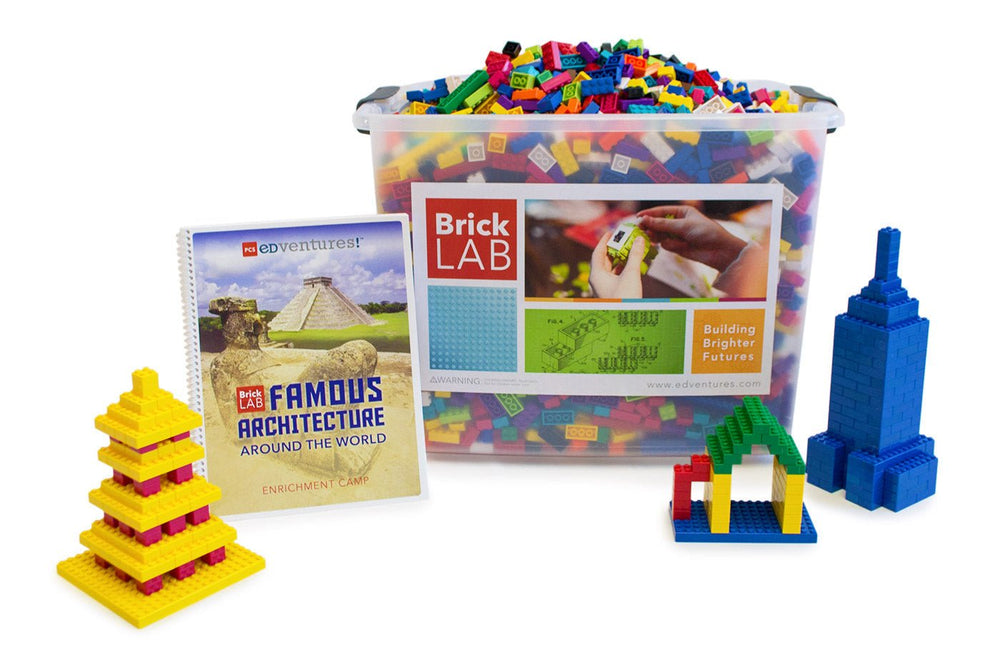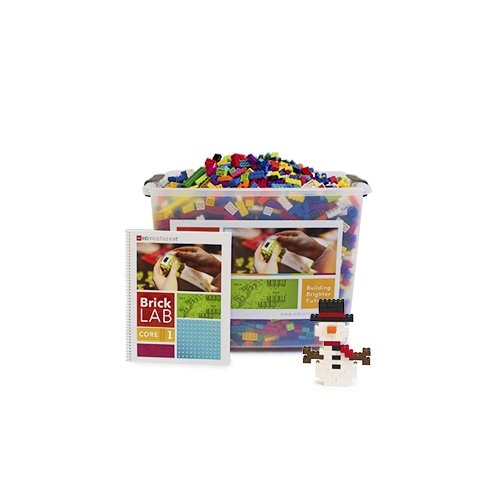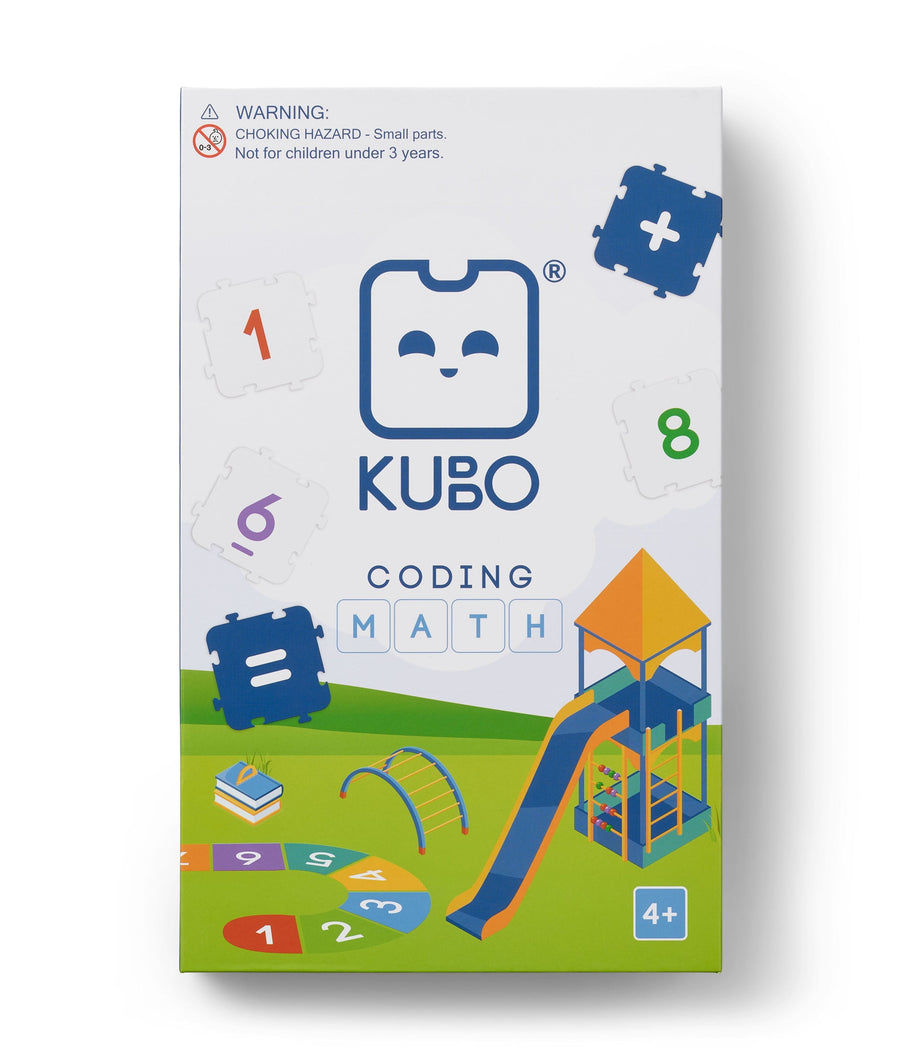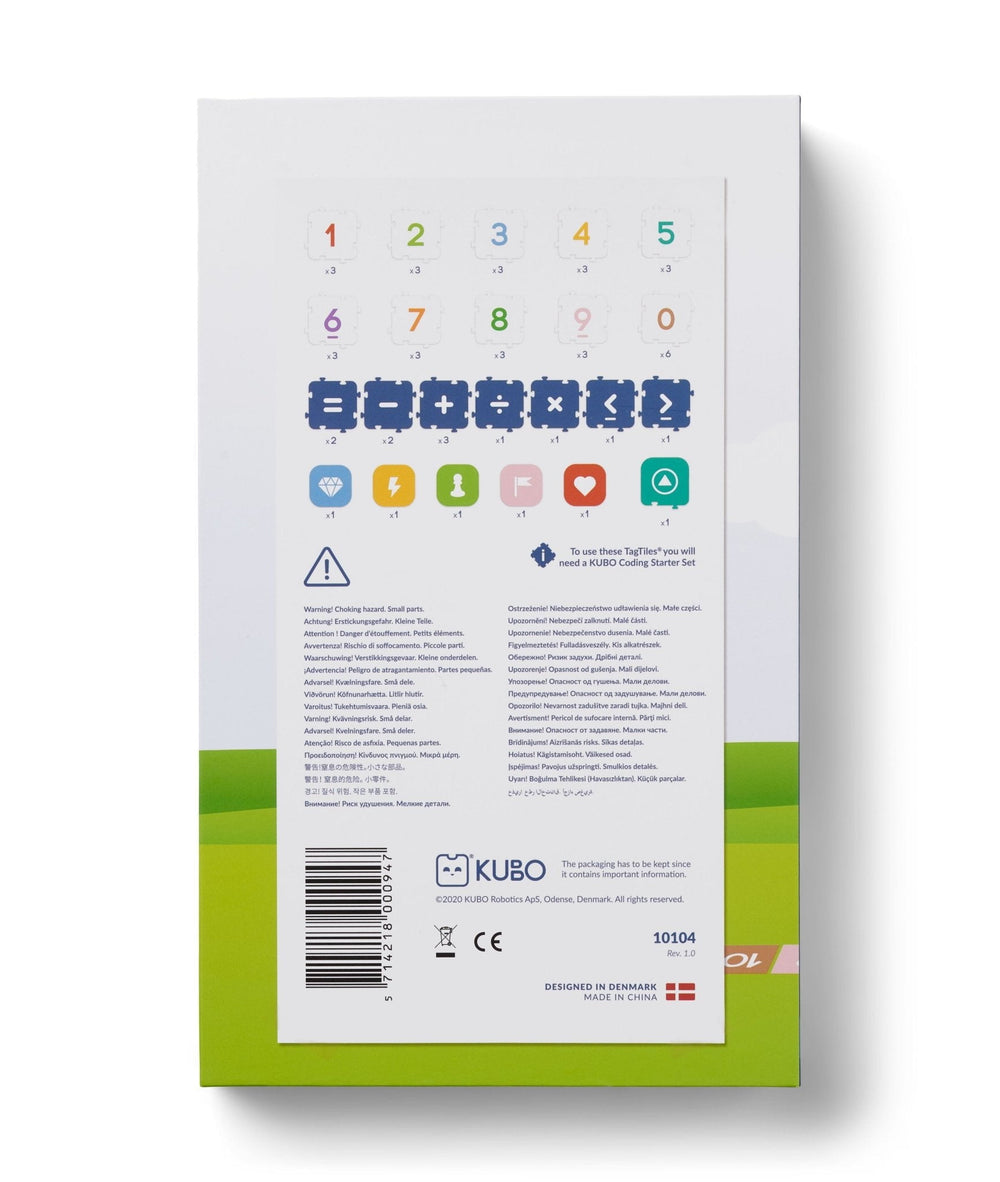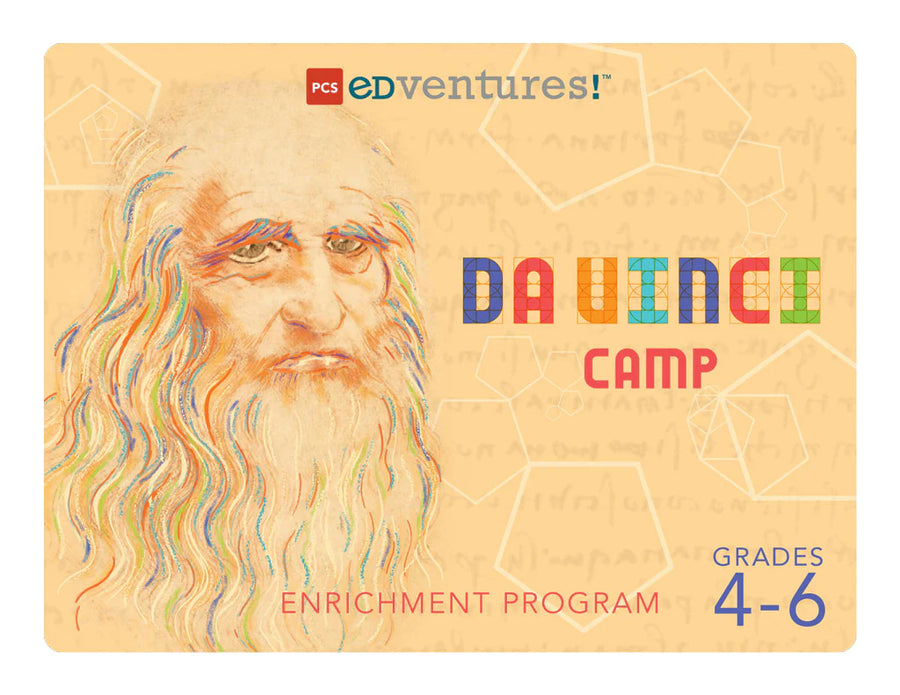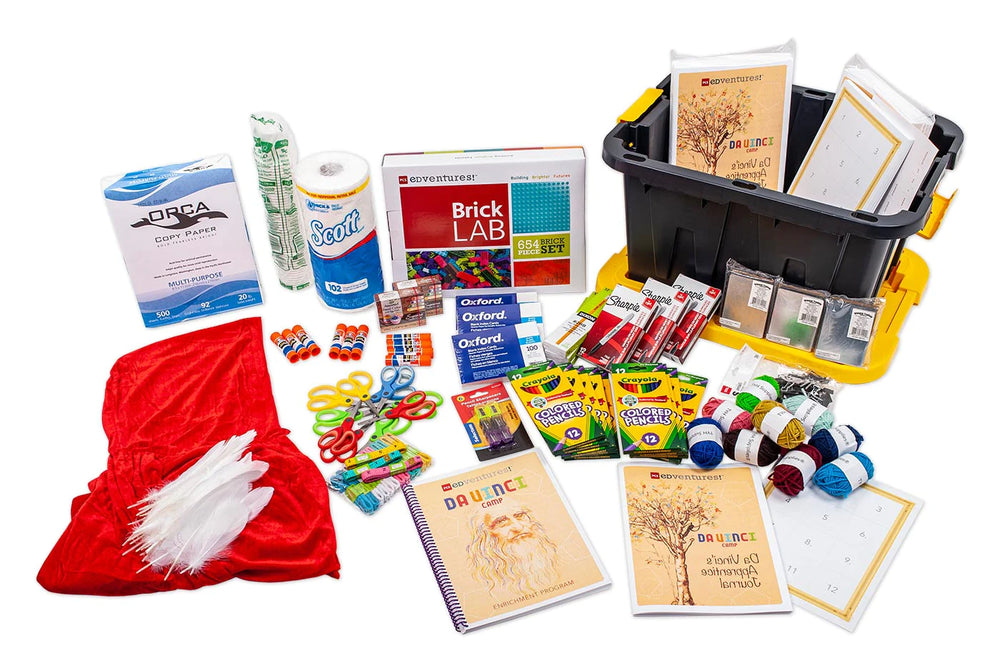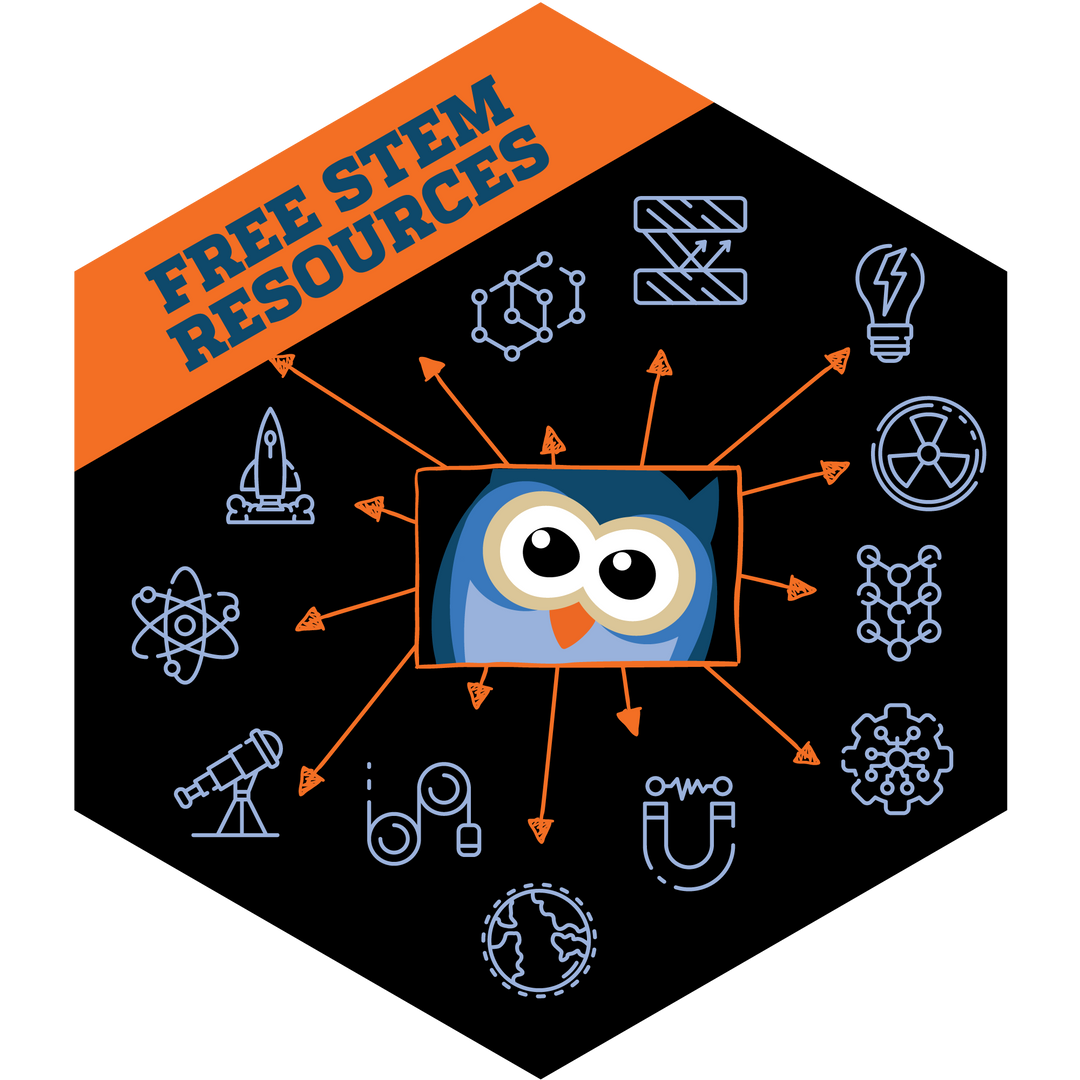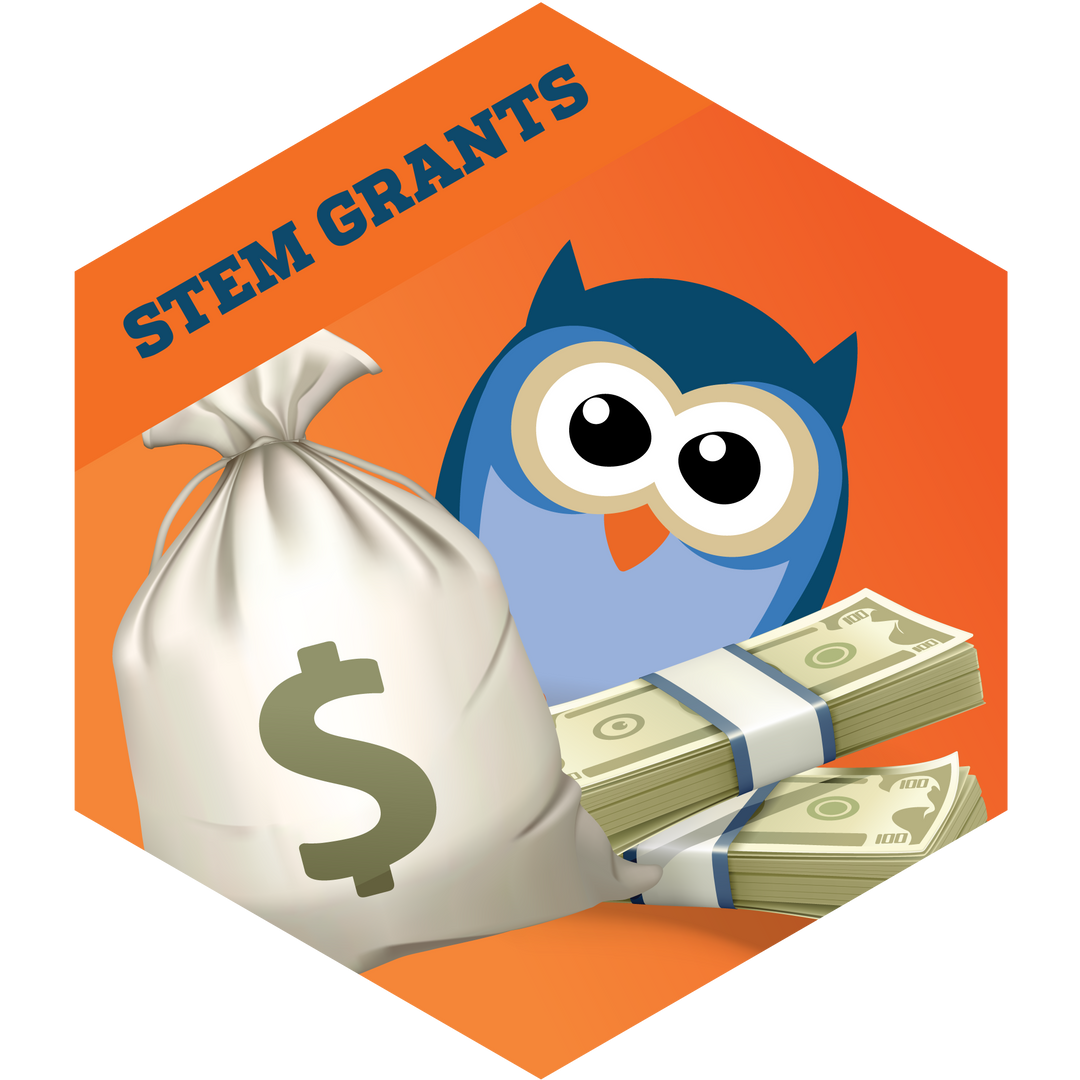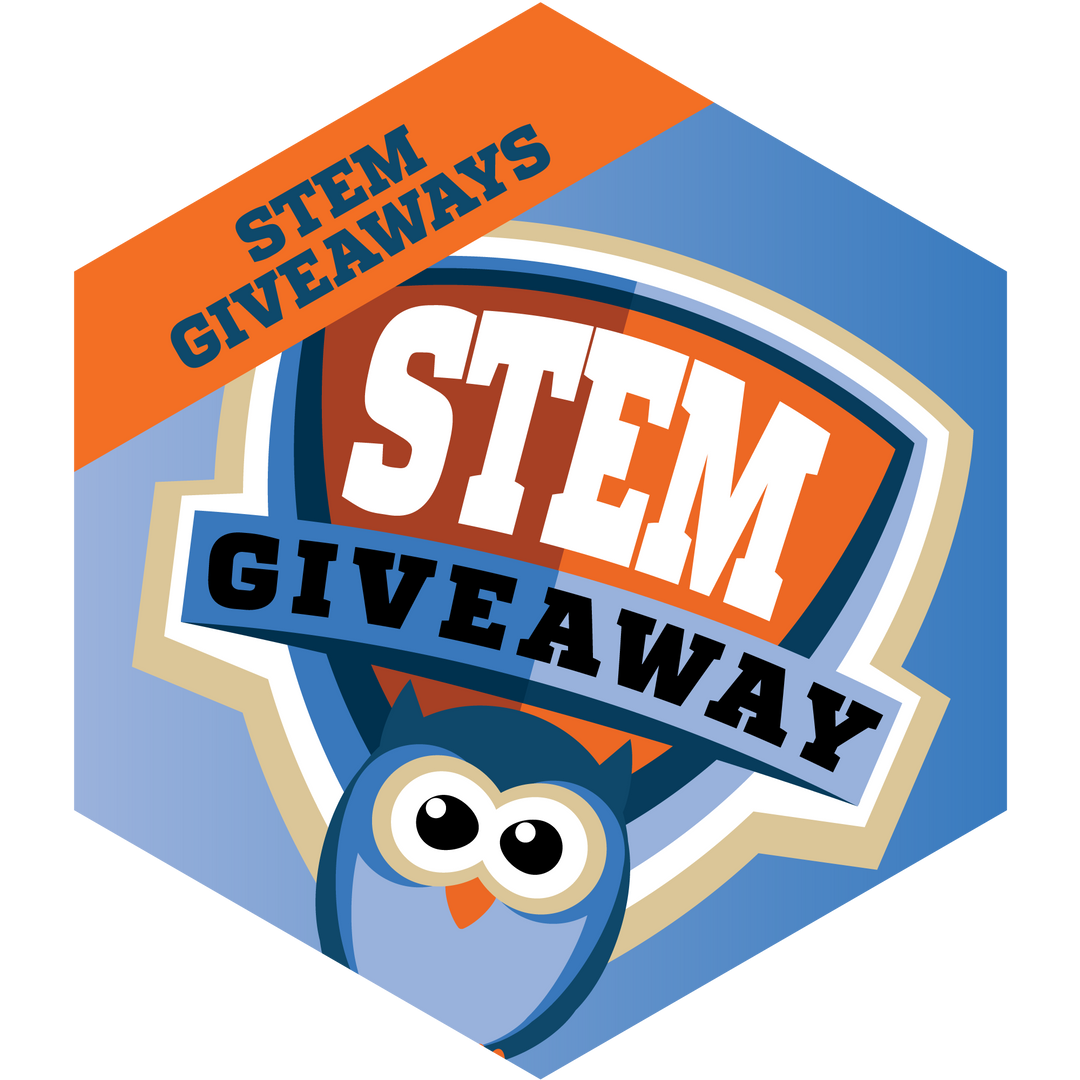Food STEAMventures
- Grades: TK-K
- Number of Students: Up to 30
- Number of Lessons: 14
- Hours of Content: 12+
- Additional Resources: Curriculum Sample
Highlights:
STEAMventures: Fueling Curiosity, Igniting Innovation
Plant the seeds of discovery in STEAM curriculum for transitional and kindergarten students that takes young learners on an exciting two-part journey exploring farms and gardens. “Farms” provides insights into farm life, featuring animals, tractors, buildings and crops. In “Gardens,” students closely examine food, design greenhouses and plant their own mini gardens.
Along the way, the curriculum seamlessly integrates foundational math and English Language Arts through activities like counting, coloring and engaging art projects. With step-by-step lessons that blend fun, movement, hands-on experiences, creativity and problem-solving, Food STEAMventures is your blueprint for creating an enriching environment where young minds flourish.
Recommended Setting:
- Summer Camps
- Classrooms
- Out-of-School Time Programs
Curriculum or Lesson Topics:
Subject Targets:
- Life Science
- Earth Science
- Technology
- Engineering Design
- Art/STEAM
- Math
- English Language Arts
Curriculum Topics:
- Brick Sorting
- Alphabet Adventures
- Farms vs Gardens
- Brick Builds
- Parts of Plants
- Engineering Exploration
- Smart Farming
- What Am I Eating?
- Artistic Creations
- Mathematician's Challenge
- Career Exploration
- Let’s Go on an Outing!
- Greenhouse and Container Gardens
- Growing Kindness
Standards Alignment:
Habits of Mind:
16 thinking habits developed by Art Costa and Bena Kallick to empower students to succeed in a 21st-century learning environment.
- Persisting
- Managing Impulsivity
- Listening with Understanding and Empathy
- Thinking Flexibly
- Thinking about Thinking (Metacognition)
- Striving for Accuracy
- Questioning and Posing Problems
- Applying Past Knowledge to New Situations
- Thinking and Communicating with Clarity and Precision
- Gathering Data through All Senses
- Creating, Imagining, Innovating
- Responding with Wonderment and Awe
- Taking Responsible Risks
- Finding Humor
- Thinking Interdependently
- Remaining Open to Continuous Learning
21st Century Skills:
A set of widely-applicable abilities essential for success in the information age.
- Creativity and Innovation
- Critical Thinking and Problem Solving
- Communication and Collaboration
- Flexibility and Adaptability
- Information, Media, and Technology Literacy
- Social and Cross-Cultural Skills
- Productivity and Accountability
- Leadership and Responsibility
- Initiative and Self Direction
© 2019 Battelle for Kids. battelleforkids.org. All Rights Reserved. Battelle for Kids was not involved in the production of this product and does not endorse it.
Next Generation Science Standards:*
- NGSS K-2-ETS1-1: Engineering Design
- NGSS K-2-ETS1-2: Engineering Design
- NGSS K-ESS2-1: Weather and Climate
- NGSS K-ESS3-1 Earth and Human Activity
- NGSS K-LS1-1: Energy Flow in Organism
* Next Generation Science Standards and NGSS is a registered trademark of WestEd. Neither WestEd nor the lead states and partners that developed the Next Generation Science Standards were involved in the production of this product, and do not endorse it.
Common Core State Standards for Mathematics:
- CCSS.MATH.CONTENT.K.CC.B.4: Understand the relationship between numbers and quantities; connect counting to cardinality.
- CCSS.MATH.CONTENT.K.CC.B.5: Count to answer "how many?" questions about as many as 20 things arranged in a line, a rectangular array, or a circle, or as many as 10 things in a scattered configuration; given a number from 1-20, count out that many objects.
- CCSS.MATH.CONTENT.K.CC.C.6: Identify whether the number of objects in one group is greater than, less than, or equal to the number of objects in another group, e.g., by using matching and counting strategies.
- CCSS.MATH.CONTENT.K.G.A.1: Describe objects in the environment using names of shapes, and describe the relative positions of these objects using terms such as above, below, beside, in front of, behind, and next to.
- CCSS.MATH.CONTENT.K.G.A.2: Correctly name shapes regardless of their orientations or overall size.
- CCSS.MATH.CONTENT.K.G.B.4: Analyze and compare two- and three-dimensional shapes, in different sizes and orientations, using informal language to describe their similarities, differences, parts (e.g., number of sides and vertices/"corners") and other attributes (e.g., having sides of equal length).
- CCSS.MATH.CONTENT.K.G.B.5: Model shapes in the world by building shapes from components (e.g., sticks and clay balls) and drawing shapes.
- CCSS.MATH.CONTENT.K.G.B.6: Compose simple shapes to form larger shapes. For example, "Can you join these two triangles with full sides touching to make a rectangle?"
- CCSS.MATH.CONTENT.K.MD.A.1: Describe measurable attributes of objects, such as length or weight. Describe several measurable attributes of a single object.
- CCSS.MATH.CONTENT.K.MD.A.2: Directly compare two objects with a measurable attribute in common, to see which object has "more of"/"less of" the attribute, and describe the difference. For example, directly compare the heights of two children and describe one child as taller/shorter.
- CCSS.MATH.CONTENT.K.MD.B.3: Classify objects into given categories; count the numbers of objects in each category and sort the categories by count.
- CCSS.MATH.CONTENT.K.OA.A.1: Represent addition and subtraction with objects, fingers, mental images, drawings, sounds (e.g., claps), acting out situations, verbal explanations, expressions, or equations.
- CCSS.MATH.CONTENT.K.OA.A.2: Solve addition and subtraction word problems, and add and subtract within 10, e.g., by using objects or drawings to represent the problem.
- CCSS.MATH.CONTENT.K.OA.A.3: Decompose numbers less than or equal to 10 into pairs in more than one way, e.g., by using objects or drawings, and record each decomposition by a drawing or equation (e.g., 5 = 2 + 3 and 5 = 4 + 1).
© Copyright 2010. National Governors Association Center for Best Practices and Council of Chief State School Officers. All rights reserved.
Common Core State Standards for English Language Arts:
- CCSS.ELA-LITERACY.L.K.4: Determine or clarify the meaning of unknown and multiple-meaning words and phrases based on kindergarten reading and content.
- CCSS.ELA-LITERACY.L.K.4.A: Identify new meanings for familiar words and apply them accurately (e.g., knowing duck is a bird and learning the verb to duck).
- CCSS.ELA-LITERACY.L.K.5.A: Sort common objects into categories (e.g., shapes, foods) to gain a sense of the concepts the categories represent.
- CCSS.ELA-LITERACY.L.K.5.C: Identify real-life connections between words and their use (e.g., note places at school that are colorful).
- CCSS.ELA-LITERACY.L.K.6: Use words and phrases acquired through conversations, reading and being read to, and responding to texts.
- CCSS.ELA-LITERACY.RF.K.1.B: Recognize that spoken words are represented in written language by specific sequences of letters.
- CCSS.ELA-LITERACY.RF.K.4: Read emergent-reader texts with purpose and understanding.
- CCSS.ELA-LITERACY.RL.K.1: With prompting and support, ask and answer questions about key details in a text.
- CCSS.ELA-LITERACY.SL.K.1.A: Follow agreed-upon rules for discussions (e.g., listening to others and taking turns speaking about the topics and texts under discussion).
- CCSS.ELA-LITERACY.SL.K.1.B: Continue a conversation through multiple exchanges.
- CCSS.ELA-LITERACY.SL.K.2: Confirm understanding of a text read aloud or information presented orally or through other media by asking and answering questions about key details and requesting clarification if something is not understood.
- CCSS.ELA-LITERACY.SL.K.4: Describe familiar people, places, things, and events and, with prompting and support, provide additional detail.
- CCSS.ELA-LITERACY.SL.K.5: Add drawings or other visual displays to descriptions as desired to provide additional detail.
- CCSS.ELA-LITERACY.SL.K.6: Speak audibly and express thoughts, feelings, and ideas clearly.
- CCSS.ELA-LITERACY.W.K.2: Use a combination of drawing, dictating, and writing to compose informative/explanatory texts in which they name what they are writing about and supply some information about the topic.
- CCSS.ELA-LITERACY.W.K.8: With guidance and support from adults, recall information from experiences or gather information from provided sources to answer a question.
© Copyright 2010. National Governors Association Center for Best Practices and Council of Chief State School Officers. All rights reserved.
International Society for Technology in Education:
- 1.1d Technology Operations: Students understand the fundamental concepts of technology operations; demonstrate the ability to choose, use and troubleshoot current technologies; and are able to transfer their knowledge to explore emerging technologies.
- 1.3.c Curate Information: Students curate information from digital resources using a variety of tools and methods to create collections of artifacts that demonstrate meaningful connections or conclusions.
- 1.3.d Explore Real-World Issues: Students build knowledge by actively exploring real-world issues and problems, developing ideas and theories, and pursuing answers and solutions.
- 1.4 Innovative Designer: Students use a variety of technologies within a design process to identify and solve problems by creating new, useful or imaginative solutions.
- 1.4.a Design Process: Students know and use a deliberate design process for generating ideas, testing theories, creating innovative artifacts or solving authentic problems.
- 1.6.b Original and Remixed Works: Students create original works or responsibly repurpose or remix digital resources into new creations.
- 1.7.a Global Connections: Students use digital tools to connect with learners from a variety of backgrounds and cultures, engaging with them in ways that broaden mutual understanding and learning.
ISTE Standards for Students, ©2016, ISTE® (International Society for Technology in Education), iste.org. All rights reserved. ISTE was not involved in the production of this product and does not endorse it.
National Core Arts Standards:
- VA:Cn10.1.PDa: Explore the world using descriptive and expressive words and art-making.
- VA:Cn11.1.Ka: Identify a purpose of an artwork.
- VA:Cn11.1.Pka: Recognize that people make art.
- VA:Cr1.1.Ka: Engage in exploration and imaginative play with materials.
- VA:Cr1.2.PKa: Engage in self directed play with materials.
- VA:Cr2.1.Ka: Through experimentation, build skills in various media and approaches to artmaking.
- VA:Cr2.1.PKa: Use a variety of art making tools.
- VA:Cr2.2.PKa: Share materials with others.
- VA:Cr2.3.Ka: Create and tell about art that communicates a story about a familiar place or object.
- VA:Cr3.1.PKa: Share and talk about personal artwork.
- VA:Pr5.1.PKa: Identify places where art may be displayed or saved.
- VA:Re.7.2.Ka: Describe what an image represents
- VA:Re.7.2.PDa: Distinguish between images and real objects.
National Core Arts Standards © 2015 National Coalition for Core Arts Standards. Rights administered by Young Audiences, Inc. New York, NY. https://www.nationalartsstandards.org
What's Included:
Each Lesson Includes:
- Schedule
- Opening & Closing Discussion
- Step-By-Step Activity Instructions
- Topic Background Information & Vocabulary
- Materials List
Complete Program Includes:
- Instructor Guide: 1
- BrickLAB Fruit Charade Card Set: 5
- Sets of Builds: 30
- Sets of Consumable Student Pages: 30
- Set of Reusable Student Pages: 1
- Large Storage Bins with Lids: 2
- Mesh Bag (for cleaning bricks): 1
- Ziplock bags (100 ct.): 1
- Sets of BrickLAB Bricks: 3
- Brick Separator (for deconstructing builds): 1
- Pipe Cleaners (45–50 pack): 2
- Coffee Filters (100 ct.): 1
- Clear, Round Containers (50 pack): 2
- Small Storage Containers with Lids: 6
- Cotton Balls (bag of 100): 3
- Cotton Swabs (150+ ct.): 1
- Crayons (24 pack): 20
- Wiggly Eyes (500 pack): 1
- Geometric Die Cut Shapes (25+ pack): 1
- Glue Sticks: 30
- Washable Markers, Broad Line (8 pack):15
- White Copy Paper (500 pack):1
- Construction Paper (assorted colors, 50 sheets): 1
- Construction Paper (bright green, 50 sheets): 1
- Construction Paper (brown, 50 sheets): 1
- Construction Paper (red, 50 sheets): 1
- Paper Plates: 200
- Plant Pots (24 ct.): 2
- Golf Pencils (50+ pack): 1
- Scissors: 30
- Wheatgrass Seeds for Lesson 15 (16 oz.): 1
- Marigold Seeds for Lesson 24 (500 ct.): 1
- Spoons: 50
- Tangrams (set of 28): 3
- Roll of Masking Tape: 1
- Tempera Paint (16 oz., blue): 1
- Tempera Paint (16 oz., red): 1
- Tempera Paint (16 oz., yellow): 1
- Access to Digital Resource Portal


